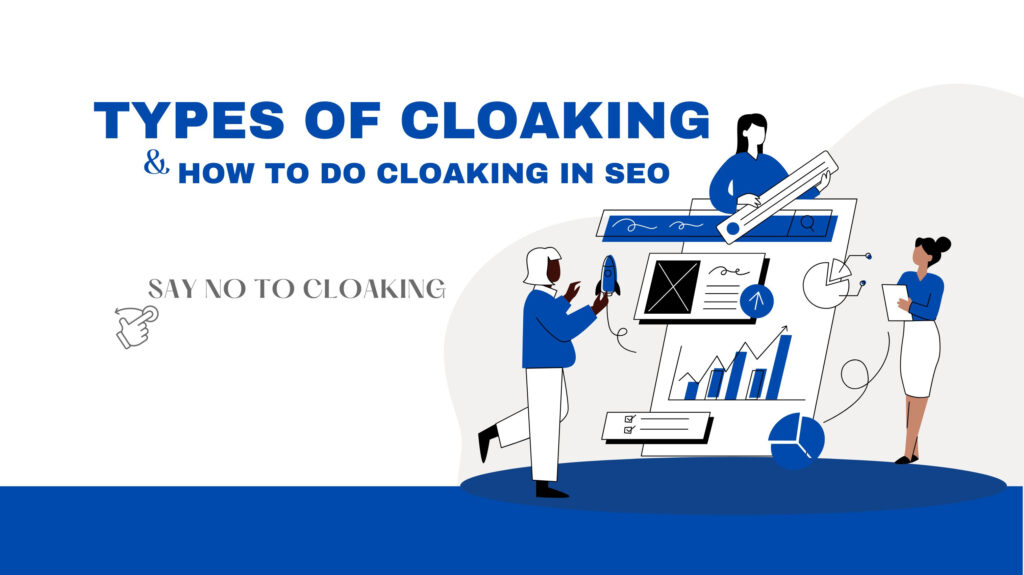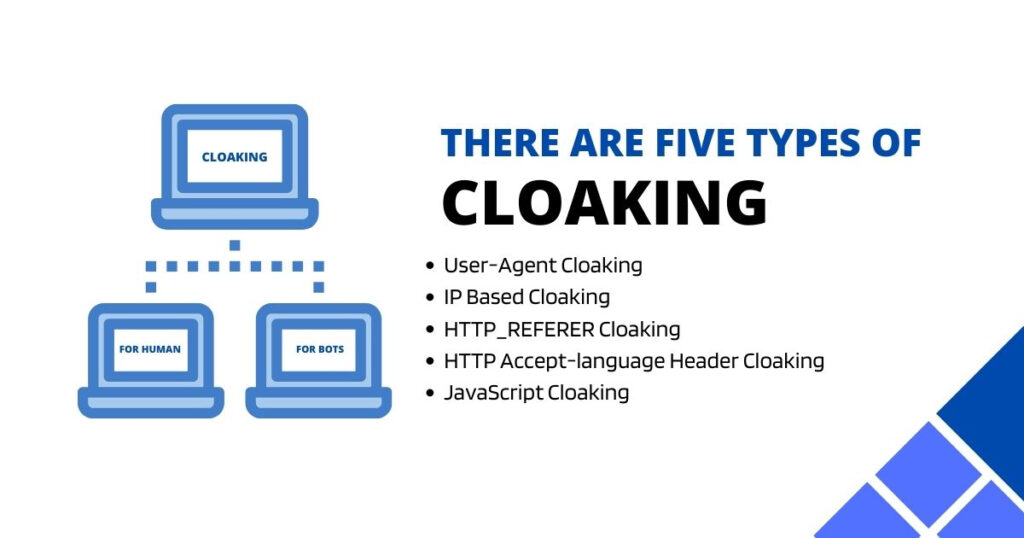
We all want our web page or website to rank first on the Search Engine Results Page (SERP).
It is simply a matter of optimizing our website so that it looks worthy of a good ranking in search engines.
In search engine optimization, this can be a long-term process, and we don’t want to wait for it.
It is easy to achieve the top SERP results by using “black hat SEO techniques.”
Cloaking in SEO is one way to do this. Let’s talk some more.
Types of Cloaking in SEO, and how to do it?

There are five types of cloaking in SEO to get traffic and rankings faster.
Search engines don’t like this practice and may penalize such sites if they are found to be using SEO cloaking techniques.
There Are Five Types Of Cloaking In SEO
- User-Agent Cloaking
- IP based cloaking
- HTTP_REFERER cloaking
- HTTP Accept-language header cloaking
- JavaScript cloaking
User-Agent Cloaking
Many site owners also use this SEO cloaking technique.
In this case, a web browser acts as a user agent to hide the actual identity of a site.
Whenever you type a query into a browser, a code is transmitted to the server that identifies and recognizes the user agent.
If the user agent is a crawler, it sends cloak content.
When a crawler is detected as a user agent, cloak content is sent to the crawler.
IP based cloaking
In SEO, this is one of the most popular cloaking techniques.
Using the user’s IP address, users are redirected from a pre-rated web page to the desired page.
Using reverse DNA, a site’s honorarium identifies a user’s IP address.
After that, .htaccess was configured to redirect it to the correct web page.
HTTP_REFERER Cloaking
This SEO cloaking technique uses the HTTP_REFERER header to identify the user and send him hidden or non-cloaked content.
HTTP Accept-language header cloaking
This technique involves identifying the user’s HTTP Response Language headers to serve hidden content.
If the user is a search engine, then hidden content will be displayed to him.
JavaScript Cloaking
Using this technique, content is displayed differently depending on whether a user is able to use JavaScript or not.
JavaScript is disabled in search engines, so hidden content is displayed to them.
How To Do Cloaking in SEO

Here are some of the SEO cloaking ways that some websites use to get more traffic and move up in the rankings.
But it can help you in the short term and hurt you in the long term.
SEO cloaking may result in your site being blacklisted and removed from Google search results.
Invisible or Hidden text
By adding text in the same color as the background, it will not be visible to the human eye. is called invisible or hidden text cloaking
Flash-based Websites
According to SEO guidelines, a Flash-based website is not recommended.
The problem is that some websites cannot avoid this.
Instead of rebuilding the entire site in plain HTML, they create content-rich web pages that are submitted to search engines and displayed to users.
HTML Rich Websites
An effective website should have a lot of textual content. In order to achieve this, you need to write long content.
But there are some websites that have short content, so their ratio of textual content is low.
These types of sites use SEO cloaking to get higher rankings.
Replacement of Java Scripts
By doing so, different web pages are served to JavaScript-enabled and JavaScript-disabled user search engines.
In addition to displaying content to JavaScript-disabled users, it can be used as a search engine that matches text info from Flash or other multimedia sources.
Email Cloaking
In email cloaking, the sender’s identity and address are hidden so that the recipient does not know who sent the email.
Conclusion
This is an improper technique in SEO guidelines, although some websites use it to increase their traffic and rankings.
In SEO, these techniques are called black hat SEO or cloaking in SEO. Scammers use them to trick search engines into ranking junk pages.
In 2022, I would not recommend using SEO cloaking techniques to increase traffic or rankings.
By using this technique, you manipulate and trick the search engine into showing unwanted pages.
In SEO, cloaking is considered a black hat practice.
FAQ’s
Why Is Cloaking Not Recommended by Google?
Cloaking is considered a violation of Google’s webmaster rules because it provides alternative results to human visitors.

Factsinsight.com is a leading blog that focuses on creating high quality, interesting and useful content about technology. We are a group of experienced writers who know a lot about the world of tech and love to stay abreast of the latest trends and developments. Our aim is to give useful and real knowledge to our people.

